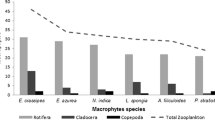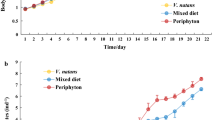Abstract
Submerged macrophytes are known to serve as refuge for zooplankton but also seem to suppress the zooplankton growth. Thus, there is a conflict between the positive and negative role of macrophytes for zooplankton. We tested the influence of physical structure using artificial macrophytes, chemicals released by a macrophyte (Myriophyllum verticillatum), as well as the combined effects of these two factors on the life history of Daphnia magna. Daphnids matured at a smaller size and produced fewer eggs but larger individual offspring in the presence of artificial and real plants. Thus, under conditions with plants, we observed a trade off between number of eggs produced and the individual size of the offspring. Daphnids grown in the presence of exudates without plants were larger at maturity and showed no reduction in clutch size as compared with the control. We suggest that the macrophytes (real and artificial) negatively affected the daphnids in two ways: (1) food particles were settling down faster on the plant structures and this reduced the available food for Daphnia, (2) the plant structures were obstacles for the daphnids causing them to spent more energy during swimming. Both effects resulted in a reduced somatic growth, whereas the increased individual offspring size was probably a response to the reduced food level. Daphnia was not negatively affected by Myriophyllum exudates.




Similar content being viewed by others
References
van den Berg MS, Coops H, Noordhuis R, van Schie J, Simons J (1997) Macroinvertebrate communities in relation to submerged vegetation in two Chara-dominated lakes. Hydrobiologia 342/343:143–150
Burks RL, Jeppesen E, Lodge DM (2000) Macrophyte and fish chemicals suppress Daphnia growth and alter life history traits. Oikos 88:139–147
Carpenter SR, Lodge M (1986) Effects of submersed macrophytes on ecosystem processes. Aquat Bot 26:341–370
Choi C, Bareiss C, Walenciak O, Gross EM (2002) Impact of polyphenols on growth of the aquatic herbivore Acentria ephemerella. J Chem Ecol 28:2245–2256
Dodson SI, Havel JE (1988) Indirect prey effects - some morphological and life-history responses of Daphnia pulex exposed to Notonecta undulata. Limnol Oceanogr 33:1274–1285
Dorgelo J, Heykoop M (1985) Avoidance of macrophytes by Daphnia longispina. Verh Internat Verein Limnol 22:3369–3372
Gliwicz ZM, Guisande C (1992) Family planning in Daphnia: resistance to starvation in offspring born to mothers grown at different food levels. Oecologia 91:463–467
Gross EM (2003) Allelopathy of aquatic autotrophs. Crit Rev Plant Sci 22:313–339
Guillard RRL, Lorenzen CJ (1972) Yellow-green algae with chlorophyllide c. J Phycol 8:10–14
Guisande C (1993) Reproductive strategy as population density varies in Daphnia magna (Cladocera). Freshw Biol 29:463–467
Gulati RD, Van Donk E (2002) Lakes in the Netherlands, their origin, eutrophication and restoration: state-of-the-art review. Hydrobiologia 478:73–106
Guma S (1978) The food and feeding habits of young perch (Perca fluviatilis L.) in Windermere. Freshw Biol 8:177–187
Hammer C (1985) Feeding behaviour of roach (Rutillus rutillus) larvae and the fry of perch (Perca fluviatilis) in Lake Lankau. Arch Hydrobiol 103:61–74
Hilt S, Ghobrial MGN, Gross EM (2006) In situ allelopathic potential of Myriophyllum verticillatum (Haloragaceae) against selected phytoplankton species. J Phycol 42:1189–1198
Horton PA, Rowan MG, Webster KE, Peters RH (1979) Browsing and grazing by cladoceran filter feeders. Can J Zool 57:206–212
Jeppesen E, Jensen JP, Sondegaard M, Lauridsen T, Pedersen LJ, Jensen L (1997) Top-down control in freshwater lakes: the role of nutrient state, submerged macrophytes and water depth. Hydrobiologia 342/343:151–164
Jeppesen E, Sondergaard M, Jensen JP, Mortensen E, Hansen AM, Jorgensen T (1998) Cascading trophic interactions from fish to bacteria and nutrients after reduced sewage loading: an 18-year study of a shallow hypertrophic lake. Ecosystems 1:250–267
Jeppesen E, Jensen JP, Sondergaard M, Lauridsen T (1999) Trophic dynamics in turbid and clearwater lakes with special emphasis on the role of zooplankton for water clarity. Hydrobiologia 408–409:217–231
Kornijow R, Gulati RD, Van Donk E (1990) Hydrophyte-macroinvertebrate interactions in Zwemlust, a lake undergoing biomanipulation. Hydrobiologia 200/201:467–474
Lauridsen TL, Lodge DM (1996) Avoidance by Daphnia magna of fish and macrophytes: chemical cues and predator-mediated use of macrophyte habitat. Limnol Oceanogr 41:794–798
Moss B (1990) Engineering and biological approaches to the restoration from eutrophication of shallow lakes in which aquatic plant-communities are important components. Hydrobiologia 200:367–377
Mulderij G, Mooij WM, Van Donk E (2005) Allelopathic growth inhibition and colony formation of green alga Scenedesmus obliquus by the aquatic macrophyte Stratiotes aloides. Aquat Ecol 39:11–21
Pennak RW (1973) Some evidence for aquatic macrophytes as repellents for a limnetic species of Daphnia. Int Revue ges Hydrobiol 58:569–576
Quayyum HA, Mallik AU, Lee PF (1999) Allelopathic potential of aquatic plants associated with wild rice (Zizania palustris): I. Bioassay with plant and lake sediment samples. J Chem Ecol 25:209–220
Rybak JI (1996) The swimming behaviour of planktonic crustaceans colonizing algal mats. Hydrobiologia 337:183–186
Scheffer M (1998) Ecology of shallow lakes. Population and community biology Series, vol 22. Kluwer Academic Publishers, Dordrecht
Schriver PJ, Bøgestrand E, Jeppesen E, Søndergaard M (1995) Impact of submerged macrophytes on fish – zooplankton – phytoplankton interactions: large scale enclosure experiments in a shallow eutrophic lake. Freshw Biol 33:255–270
Smiley E, Tessier AJ (1998) Environmental gradients and horizontal distribution of microcrustaceans in lakes. Freshw Biol 39:397–409
Stansfield JH, Perrow MR, Tench LD, Jowitt AD, Taylor AAL (1997) Submerged macrophytes as refuges for grazing Cladocera against fish predation: observations on seasonal changes in relation to macrophyte cover and predation pressure. Hydrobiologia 242/243:229–240
Tessier AJ, Henry LL, Goulden CE (1983) Starvation in Daphnia: Energy reserves and reproductive allocation. Limnol Oceanogr 28:667–676
Timms RM, Moss B (1984) Prevention of growth of potentially dense phytoplankton populations by zooplankton grazing, in the presence of zooplanktivorous fish, in a shallow wetland ecosystem. Limnol Oceanogr 29:472–486
Van Donk E, Gulati RD (1995) Transition of a lake to turbid state 6 years after biomanipulation: mechanisms and pathways. Water Sci Technol 32:197–206
Weber A (2001) Interactions between predator Kairomone and food level complicate the ecological interpretation of Daphnia laboratory results. J Plankton Res 23:41–46
Wium-Andersen S, Anthoni U, Christophersen C, Houen G (1982) Allelopathic effects on phytoplankton by substances isolated from aquatic macrophytes (Charales). Oikos 39:187–190
Acknowledgements
This work was funded in part by Dean of Faculty of Biology, Adam Mickiewicz University; grant no. PBWB 211/2000 and EU Project SWALE. We are grateful to Drs. Koos Vijverberg, Harold G. Marshall and Todd Egerton for comments on the draft of manuscript. Three anonymous reviewers are acknowledged for their very constructive reviews.
Author information
Authors and Affiliations
Corresponding author
Rights and permissions
About this article
Cite this article
Cerbin, S., van Donk, E. & Gulati, R.D. The influence of Myriophyllum verticillatum and artificial plants on some life history parameters of Daphnia magna . Aquat Ecol 41, 263–271 (2007). https://doi.org/10.1007/s10452-007-9091-5
Received:
Accepted:
Published:
Issue Date:
DOI: https://doi.org/10.1007/s10452-007-9091-5




